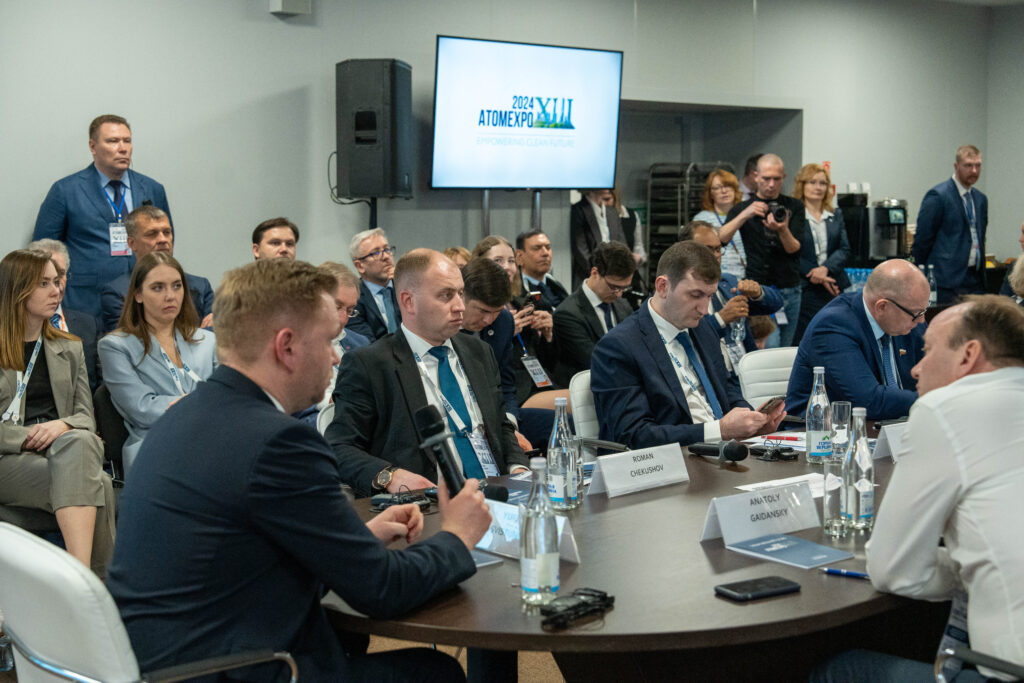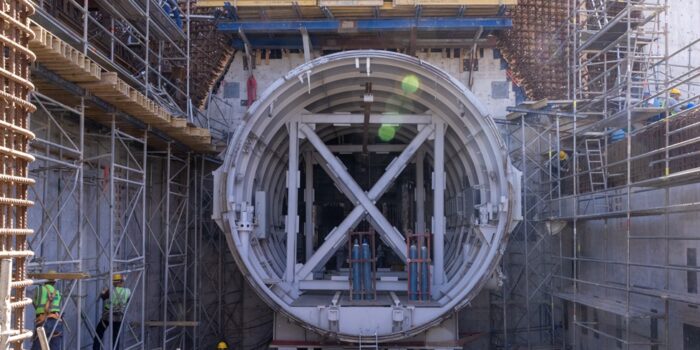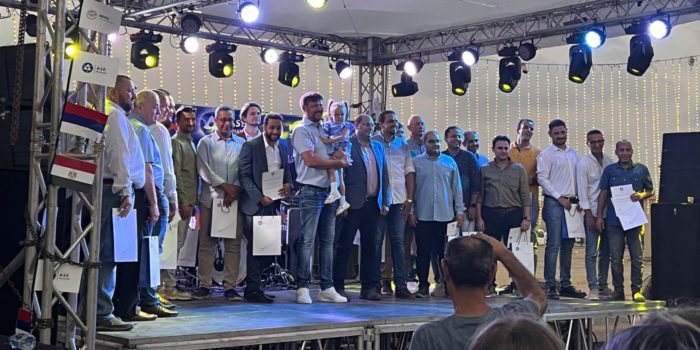On 25 March, the round table “Industry of the future: market for composites and introduction of additive technologies as seen through the lens of international co-operation” with participation of experts from India, Middle East and Russia took place as part of the business programme of the forum ATOMEXPO-2024.
The speakers at the round table were Alexander Tyunin, Director General of Rosatom’s Division for Composites; Ilya Kavelashvili, Director General of Rosatom’s company integrating additive-technology solutions; Mr. Chandrashekhar Dandekar, Chair of Dandekar Brothers; Mr. Rahul Gaywala, CEO STPL; Konstantin Dolgov, Deputy Chairman of the RF Federation Council Committee on Economic Policy, and others.
The key topic of the expert round table was the necessity to exchange experience in the development of the composites industry and additive technologies with the countries showing an objective need in their use. Besides, the discussion was specially focused on the demonstration of real-world cases, growth points. It also highlighted the consolidated stance of the experts that traditional approaches to the industrial use of classic materials and methods are starting to give way to breakthrough technology.
“The Russian market of composites is growing by 5% every year. This sends us a very clear message that there is a need for composites, and more importantly, there are three obvious trends. Firstly, the need to develop technology for accelerated moulding of final products; secondly, the integration of raw material leaders with base material processors and manufacturers of composite products; and thirdly, recycling as a mandatory element of the process chain”, said Alexander Tyunin, Director General of Rosatom’s Division for Composites.

“There is a huge opportunity for the nuclear power industry to develop additive technologies in any country, as Rosatom presents integrated solutions and has already achieved significant results along the entire production chain. Having created a line-up of 3D printers based on various printing technologies, it has developed the software, it produces metal powders and provides 3D-printing services,” said Ilya Kavelashvili, Director General of Rosatom’s company integrating additive-technology solutions.
“Innovative materials and technologies are now facing a vast array of opportunities. The more areas where composites and 3D printing can replace classical materials in terms of serial production, the greater the chance to stir up quite a revolution,” said Anatoly Gaidansky, Director General of AeroComposite JSC.
Mikhail Bakradze, Deputy Director General / Head of the Priority Vector “Engine Building Technology” at the United Engine Corporation, brought up real-world cases of the use of composites and additive technology, particularly, the use of thermoplastic polymer composites in the engine nacelle structures, as well as introduction of 3D printing into the production cycle.
Olga Ospennikova, Director of the Association for the Development of Additive Technologies noted that additive technologies are becoming more and more accessible and are used in civilian applications: medicine, automotive industry, as well as educational projects.

Participants from India confirmed that both industries are witnessing tremendous growth, and concluded that technology sharing and joint product strategies are required to effectively develop these industries. Furthermore, the promotion of co-operation in the capacity-building and thorough study of opportunities for the use of governmental support will also boost the wider expansion of additive technologies and introduction of composites in various industries.
Reference
Rosatom State Corporation’s Division for Composites is Russia’s leader in the production of PAN precursor, carbon and glass fibre, fabrics, prepregs and finished products based on them. It unites an R&D centre and industrial facilities where a complete production chain from oil refining products to finished goods has been set up. The Division consists of 29 companies, including 15 plants in 16 Russian regions.
Additive technologies have a number of undeniable advantages: they make it possible to produce products of the most complex shapes, which are difficult to achieve by using traditional machining or casting. In addition, 3D printing makes it possible to significantly reduce the product weight and the production time of prototypes. Modern 3D printers also have the ability to quickly reconfigure printing parameters to manufacture products of different purposes or sizes, single or mass production. Products printed on 3D printers are used in a wide range of applications, from nuclear and space technology to medicine.
Rosatom was the first major Russian company to develop technologies and manufacture equipment for 3D printing. In recent years, a full production chain has been created within the structure of the State Corporation, including the manufacture of 3D printers, software development, production of metal powders, and provision of 3D printing services. At the same time, the nuclear industry is both a supplier and a major customer in the field of additive manufacturing technologies and is actively implementing them in the business processes. A regional network of additive technology centers is being developed. That is how Rosatom contributes to solving the tasks in strengthening national technological sovereignty.
Rosatom enterprises have developed 3D printers that use SLM (Selective Laser Melting), DMD (Direct Metal Deposition), EBAM (Electron Beam Additive Manufacture) FDM (Fused Deposition Modeling) technologies. Depending on the technology, the materials for printing are metal powder compositions, metal wires or plastic. In addition, Rosatom is implementing research and industrial projects to develop new technologies and products for 3D printing. The State Corporation is also actively working on the development of the regulatory framework and standardization of the new industry of additive technologies in the Russian Federation.
TVEL Fuel Company of Rosatom (the Fuel division of Rosatom) includes enterprises for nuclear fuel production, uranium conversion and enrichment, production of gas centrifuges, as well as research and design organizations. Being the sole supplier of nuclear fuel for Russian nuclear power plants, TVEL provides fuel for a total of 70 power reactors in 15 countries, research reactors in nine countries, and transport reactors of the Russian nuclear fleet. Every sixth power reactor in the world is fueled by TVEL fuel. Rosatom’s Fuel Division is the world’s largest producer of enriched uranium, as well as the leader of the global stable isotope market. The Fuel Division is actively developing new businesses in chemistry, metallurgy, energy storage technologies, 3D printing, digital products, and decommissioning of nuclear facilities. Rosatom’s industry integrators for additive technologies and energy storage systems have been created within the TVEL Fuel Company circuit.
The activities of the nuclear industry integrator in the field of additive technologies (3D printing) are focused on four key areas, such as manufacturing a line of 3D printers and their components, creating materials and metal powders for 3D printing, developing complex software for additive systems, and performing 3D printing services and implementation of additive technologies in production (including the organization of production centers).
As part of the demonstration of Rosatom’s commitment to the climate agenda, the carbon footprint of the 13th International Forum ATOMEXPO-2024 will be compensated using special certificates.





